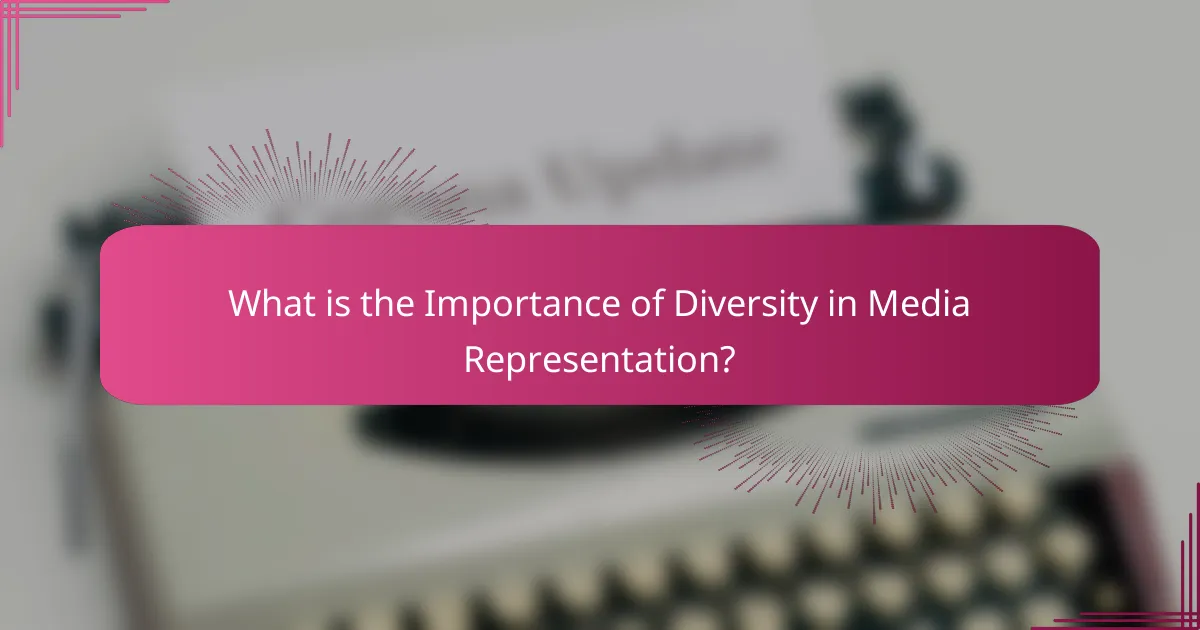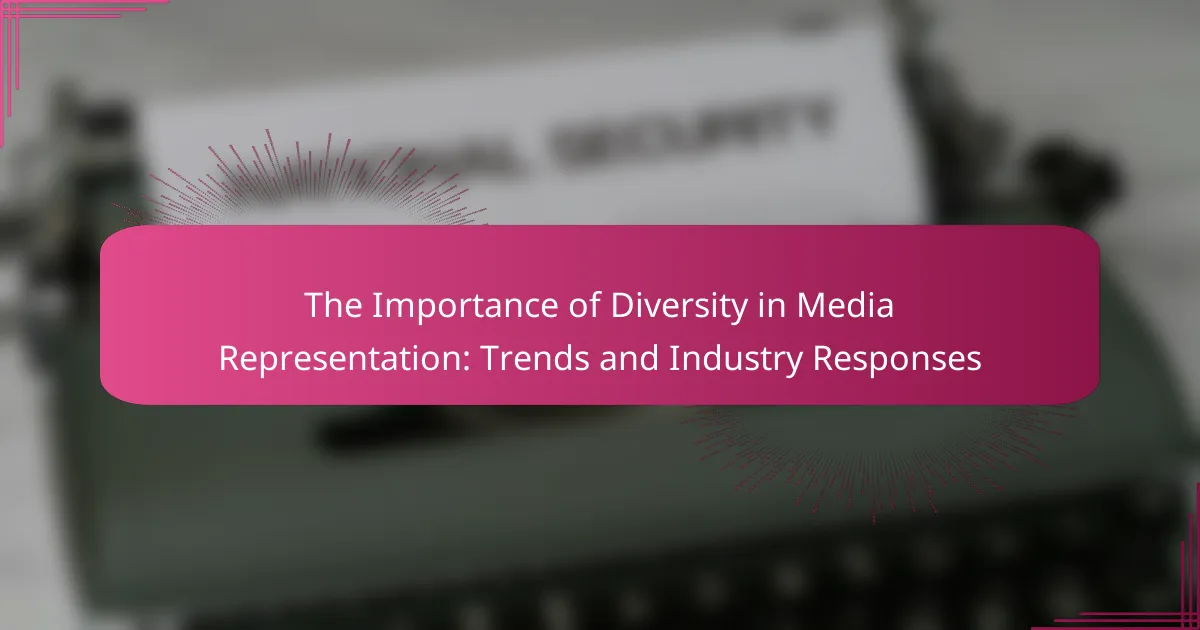Diversity in media representation plays a vital role in accurately reflecting the varied experiences of society, encompassing different cultures, identities, and perspectives. This representation not only fosters understanding and empathy among audiences but also enhances creativity and innovation in storytelling, as evidenced by a 2020 McKinsey report linking diverse teams to improved financial performance. Furthermore, effective media representation empowers marginalized groups and challenges existing stereotypes, contributing to social change and promoting equality. The article will explore current trends in diversity within media representation and the responses from the industry to address these critical issues.

What is the Importance of Diversity in Media Representation?
Diversity in media representation is crucial for reflecting the varied experiences of society. It allows for a more accurate portrayal of different cultures, identities, and perspectives. This representation fosters understanding and empathy among audiences. Studies show that diverse media can lead to increased creativity and innovation in storytelling. For instance, a 2020 report by McKinsey found that diverse teams produce better financial performance. Furthermore, representation can empower marginalized groups and challenge stereotypes. By showcasing a range of voices, media can contribute to social change and promote equality.
Why is diversity in media representation crucial for society?
Diversity in media representation is crucial for society because it fosters inclusivity and reflects the real-world demographics. When media includes varied perspectives, it enhances understanding among different cultural and social groups. Studies show that diverse representation can lead to improved social cohesion. For instance, the Annenberg Inclusion Initiative found that diverse media portrayals can challenge stereotypes and reduce prejudice. Moreover, representation affects self-esteem and identity among underrepresented communities. Research indicates that individuals exposed to diverse media are more likely to empathize with others. Thus, diversity in media is essential for promoting equality and social justice.
What are the historical contexts influencing media representation?
Historical contexts influencing media representation include colonialism, civil rights movements, and technological advancements. Colonialism shaped early media narratives, often portraying colonized peoples negatively. The civil rights movements of the 1960s challenged these narratives, demanding more accurate and diverse representations. Technological advancements, such as the rise of the internet, have democratized content creation. This shift has allowed marginalized voices to share their stories. Historical events like the feminist movement also pushed for better representation of women in media. Each of these contexts has significantly impacted how different groups are portrayed in media today.
How does media representation impact cultural perceptions?
Media representation significantly impacts cultural perceptions by shaping societal norms and values. It influences how individuals view themselves and others based on the portrayals they see. Positive representation can foster understanding and acceptance across diverse communities. Conversely, negative or stereotypical portrayals can perpetuate biases and reinforce harmful stereotypes. Research indicates that consistent exposure to diverse media representations correlates with increased empathy and reduced prejudice. For example, a study by the American Psychological Association found that diverse media representation can enhance social cohesion and promote inclusivity. Thus, the way media depicts different cultures plays a crucial role in informing public perceptions and attitudes.
What are the current trends in diversity within media representation?
Current trends in diversity within media representation include increased visibility of underrepresented groups. Media platforms are showcasing more stories featuring diverse characters. This includes racial minorities, [censured] individuals, and people with disabilities. Research by the USC Annenberg Inclusion Initiative shows that representation in film has improved slightly over the past few years. For instance, in 2020, 31.4% of speaking characters in films were from underrepresented racial/ethnic groups. Streaming services are also prioritizing diverse content to appeal to broader audiences. Additionally, there is a growing demand for authentic storytelling from creators of diverse backgrounds. This trend reflects a societal shift towards inclusivity and representation.
Which demographics are currently underrepresented in media?
Women, people of color, and individuals with disabilities are currently underrepresented in media. According to the 2021 Hollywood Diversity Report, women directed only 12% of the top 100 grossing films. Additionally, a 2020 report from the Annenberg Inclusion Initiative found that only 27.6% of film characters were from underrepresented racial/ethnic groups. Furthermore, people with disabilities accounted for just 2.7% of characters in film, as reported by the Ruderman Family Foundation. These statistics highlight the significant gaps in representation within the media landscape.
How have recent movements influenced representation trends?
Recent movements have significantly influenced representation trends in media. These movements advocate for increased diversity and inclusion across various platforms. For instance, the #MeToo movement highlighted the need for better representation of women and marginalized groups. As a result, many media organizations are revising their hiring practices. Data shows that films and shows with diverse casts perform better at the box office. Additionally, studies indicate that audiences increasingly demand authentic representation. This shift is prompting producers to prioritize stories that reflect a wider range of experiences. Overall, recent movements are reshaping the landscape of media representation.
What are the industry responses to the need for diversity in media?
The industry has responded to the need for diversity in media through various initiatives. Companies are implementing diversity hiring practices. This includes setting specific goals for representation in hiring processes. Many organizations are creating mentorship programs for underrepresented groups. These programs aim to support diverse talent in media careers.
Additionally, media outlets are focusing on inclusive storytelling. This involves featuring diverse voices and perspectives in content creation. Research shows that diverse representation leads to better audience engagement. For instance, a study by McKinsey found that companies with diverse teams are 35% more likely to outperform their peers.
Furthermore, industry awards are increasingly recognizing diversity efforts. Awards like the GLAAD Media Awards celebrate inclusive media representations. These responses indicate a growing commitment to diversity within the media landscape.
How are media companies implementing diversity initiatives?
Media companies are implementing diversity initiatives through various strategies. They are increasing the representation of diverse voices in their content. This includes hiring writers, directors, and producers from underrepresented backgrounds. Companies are also creating mentorship programs to support emerging talent. Additionally, they are conducting audits to assess diversity within their workforce. Many media organizations are setting measurable diversity goals. Reports indicate that diverse teams lead to more innovative and relatable content. For instance, a 2021 study by McKinsey found that companies with higher diversity levels outperform their peers in profitability.
What challenges do companies face in promoting diversity?
Companies face several challenges in promoting diversity. One significant challenge is unconscious bias in hiring practices. This bias can lead to a lack of diverse candidates in the recruitment process. Additionally, companies often struggle with a non-inclusive workplace culture. This culture can alienate minority employees and hinder their participation.
Another challenge is the resistance to change within the organization. Employees may be reluctant to adapt to new diversity initiatives. Limited resources can also impede diversity efforts. Many companies lack the budget or personnel to implement effective programs.
Furthermore, measuring the impact of diversity initiatives can be complex. Companies may find it difficult to track progress and outcomes. Lastly, external pressures, such as public scrutiny and social media backlash, can create additional stress. These factors can complicate the promotion of diversity within organizations.
How can improved diversity in media representation benefit audiences?
Improved diversity in media representation benefits audiences by providing a broader range of perspectives. This inclusivity fosters empathy and understanding among different cultural groups. Diverse media representation reflects the realities of society, making content more relatable. Studies show that audiences engage more with stories that resonate with their experiences. According to a 2020 report by the Annenberg Inclusion Initiative, films with diverse casts perform better at the box office. This indicates that audiences prefer content that reflects their diversity. Enhanced representation can also challenge stereotypes and reduce prejudice. Ultimately, diverse media enriches the viewing experience for all audiences.
What role does diversity play in audience engagement and loyalty?
Diversity enhances audience engagement and loyalty by making content relatable to a broader audience. When media represents various cultures and identities, it resonates with more viewers. This relatability fosters a sense of belonging among diverse audience segments. According to a study by McKinsey, companies with diverse teams are 35% more likely to outperform their peers in profitability. Engaging diverse audiences leads to increased loyalty, as viewers feel seen and valued. A report by Nielsen found that 66% of consumers prefer brands that reflect their values, including diversity. Thus, diversity is crucial for building lasting audience relationships.
How does diverse representation contribute to societal change?
Diverse representation contributes to societal change by promoting inclusivity and challenging stereotypes. It allows marginalized voices to be heard and acknowledged. When various demographics are represented, it fosters empathy and understanding among different groups. This representation can influence public perceptions and behaviors positively. Studies show that diverse media portrayals lead to increased acceptance of differences. For example, research by the Geena Davis Institute on Gender in Media highlights how diverse characters can change audience attitudes. This shift can drive policy changes and social movements. Ultimately, diverse representation helps to create a more equitable society.
What best practices can be adopted to enhance diversity in media representation?
Adopting best practices to enhance diversity in media representation involves implementing inclusive hiring practices. Media organizations should actively recruit talent from diverse backgrounds. This includes people of different races, genders, [censured] orientations, and abilities. Training programs on unconscious bias can help decision-makers recognize and address their biases.
Additionally, developing partnerships with diverse community organizations can provide insights into underrepresented perspectives. Creating advisory boards that include diverse voices can guide content creation. Regularly assessing media content for representation can identify gaps and areas for improvement.
Research shows that diverse teams produce more innovative and relatable content. A McKinsey report indicates that companies with diverse workforces are 35% more likely to outperform their peers. These practices collectively contribute to a richer and more accurate portrayal of society in media.
Which strategies have proven effective in increasing representation?
Effective strategies for increasing representation include implementing diversity hiring practices. Companies that prioritize diverse candidate pools see improved representation. Research shows that diverse teams lead to better decision-making and creativity. Mentorship programs also support underrepresented groups in advancing their careers. Training on unconscious bias helps create inclusive environments. Additionally, partnerships with diverse organizations can enhance outreach efforts. Regular assessments of diversity metrics ensure accountability and progress. These strategies collectively contribute to meaningful representation in media and beyond.
How can audiences advocate for better diversity in media?
Audiences can advocate for better diversity in media by actively supporting diverse content creators. This includes promoting films, shows, and books by underrepresented voices. Audiences should also engage with media companies through social media and direct feedback. They can express their preferences for diverse programming and representation. Participating in campaigns that promote diversity is another effective method. Research shows that diverse representation leads to increased viewer engagement. According to a 2020 report by the USC Annenberg Inclusion Initiative, films with diverse casts perform better at the box office. This data supports the idea that audiences can influence industry practices through their advocacy.
The main entity of this article is diversity in media representation. The article outlines the significance of diverse representation in accurately reflecting societal experiences, fostering understanding, and promoting equality. It discusses historical contexts, current trends, and the impact of representation on cultural perceptions and audience engagement. Additionally, it highlights industry responses, challenges faced in promoting diversity, and best practices for enhancing representation, ultimately emphasizing the role of diverse media in driving social change and improving audience loyalty.
